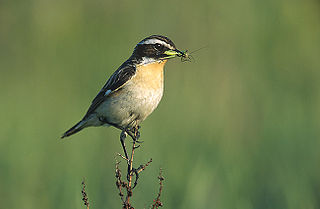
Perch is a common name for fish of the genus Perca, freshwater gamefish belonging to the family Percidae. The perch, of which three species occur in different geographical areas, lend their name to a large order of vertebrates: the Perciformes, from the Greek perke, simply meaning perch, and the Latin forma meaning shape. Many species of freshwater gamefish more or less resemble perch, but belong to different genera. In fact, the exclusively saltwater-dwelling red drum is often referred to as a red perch, though by definition perch are freshwater fish. Though many fish are referred to as perch as a common name, to be considered a true perch, the fish must be of the family Percidae.
Bass is a name shared by many species of fish. The term encompasses both freshwater and marine species, all belonging to the large order Perciformes, or perch-like fishes. The word bass comes from Middle English bars, meaning "perch".

Moles are small mammals adapted to a subterranean lifestyle. They have cylindrical bodies; velvety fur; very small, inconspicuous ears and eyes; reduced hindlimbs; and short, powerful forelimbs with large paws adapted for digging. The term "mole" is especially and most properly used for "true moles" of the Talpidae family in the order Eulipotyphla found in most parts of North America, Asia, and Europe; although it may also refer to other unrelated mammals of Australia and southern Africa which have similarly evolved the mole body plan. The term is not applied to all talpids; e.g. desmans and shrew-moles differ from the common definition of "mole".
Eucalypt is a descriptive name for woody plants with capsule fruiting bodies belonging to seven closely related genera found across Australasia:
Eucalyptus, Corymbia, Angophora, Stockwellia, Allosyncarpia, Eucalyptopsis and Arillastrum.

Chats are a group of small Old World insectivorous birds formerly classified as members of the thrush family Turdidae, but now considered Old World flycatchers.

The Pachycephalidae are a family of bird species that includes the whistlers, shrikethrushes, and three of the pitohuis, and is part of the ancient Australo-Papuan radiation of songbirds. Its members range from small to medium in size, and occupy most of Australasia. Australia and New Guinea are the centre of their diversity and, in the case of the whistlers, the South Pacific islands as far as Tonga and Samoa and parts of Asia as far as India. The exact delimitation of boundaries of the family are uncertain, and one species, the golden whistler, has been the subject of intense taxonomic scrutiny in recent years, with multiple subspecies and species-level revisions.

In biology, a monotypic taxon is a taxonomic group (taxon) that contains only one immediately subordinate taxon.

The Pterophoridae or plume moths are a family of Lepidoptera with unusually modified wings. Though they belong to the Apoditrysia like the larger moths and the butterflies, unlike these they are tiny and were formerly included among the assemblage called "microlepidoptera".

The Coleophoridae are a family of large moths, belonging to the huge superfamily Gelechioidea. Collectively known as case-bearers, casebearing moths or case moths, this family is represented on all continents, but the majority are found in temperate areas of the Northern Hemisphere. They are most common in the Palearctic, and rare in sub-Saharan Africa, South America, and Australia; consequently, they probably originated in northern Eurasia. They are relatively common in houses, they seek out moist areas to rest and procreate.

Legless lizard may refer to any of several groups of lizards that have independently lost limbs or reduced them to the point of being of no use in locomotion. It is the common name for the family Pygopodidae, but often refers to other groups, such as limbless anguids, depending on the region of the world. These lizards are often distinguishable from snakes on the basis of one or more of the following characteristics: possessing eyelids, possessing external ear openings, lack of broad belly scales, notched rather than forked tongue, having two, more-or-less equal, lungs and/or having a very long tail.
Eriocottidae or Old World spiny-winged moths is a family of insects in the order Lepidoptera whose position relative to other members of the superfamily Tineoidea is currently unknown. There are two subfamilies, Compsocteninae and Eriocottinae.

Hydromedusa is a turtle genus in the family Chelidae, commonly known as the South American snake-necked turtles. They are quite closely related to the South American side-necked swamp turtles (Acanthochelys) and the snake-necked turtles of the Australian-Melanesian region (Chelodina), but less closely to the spine-necked river turtles of South America (Podocnemididae) which belong to a more modern lineage of Pleurodira.

Diphlebiidae is no longer recognised as a biological family.
It was the name given to a small family of damselflies, the azure damselflies, with species in two genera: Diphlebia and Philoganga. Diphlebia is found in Australia and Philoganga is found in Southeast Asia. They are large and thick-bodied damselflies. They rest with their wings spread out. The Diphlebiidae were also known as Philogangidae.
Eriocottis fuscanella is a moth of the Eriocottidae family. It was described by Zeller in 1847. It is found in Italy and on Sardinia, Sicily and Malta.
Eriocottis andalusiella is a moth in the Eriocottidae family. It was described by Rebel in 1901. It is found in Portugal and Spain.
Eriocottis flavicephalana is a moth in the Eriocottidae family. It was described by Issiki in 1930. It is found in Taiwan.
Eriocottis maraschensis is a moth in the Eriocottidae family. It was described by Rebel in 1936. It is found in the Taurus Mountains in Turkey.
Eriocottis nicolaeella is a moth in the family Eriocottidae. It was described by Christian Gibeaux in 1983. It is found in France and Spain.











